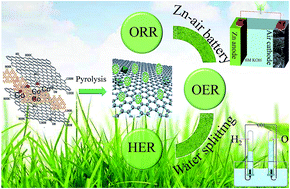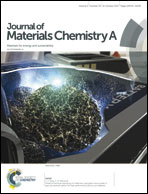Co-intercalation of multiple active units into graphene by pyrolysis of hydrogen-bonded precursors for zinc–air batteries and water splitting†
Abstract
Multifunctional electrocatalyst enabled electrochemical hydrogen/oxygen redox plays pivotal roles in variable energy conversion/storage devices and some coupling devices. The daunting challenge in developing multifunctional electrocatalysts at present is to effectively incorporate multiple active sites into one material. Herein, we presented a general protocol by a controllable pyrolysis/vapor reforming process, which allows for reconstitution to form CoNC nano-units, while preserving Co and Co oxides simultaneously. The material by co-intercalation of these active units into graphene generates outstanding trifunctional activities. The overpotentials for hydrogen and oxygen evolution reactions are 205 and 360 mV (at 10 mA cm−2), respectively, and the half-wave potential for the oxygen reduction reaction is 0.81 V, outperforming most of the state-of-the-art trifunctional electrocatalysts. A maximum power density of 23 mW cm−2 and 1000 stable cycles were realized in the as-prepared material equipped Zn–air battery. This battery further drove overall water splitting for 24 hours, at a faradaic efficiency of ca. 100% and gas production rate of 0.035 and 0.017 mL min−1 for hydrogen and oxygen, respectively. Thus this work offers a general approach to explore other efficient multifunctional electrocatalysts for application in renewable energy technologies.



 Please wait while we load your content...
Please wait while we load your content...